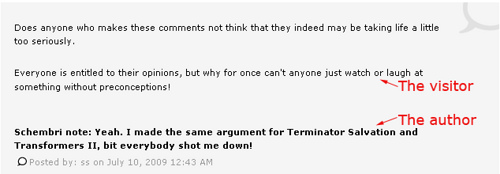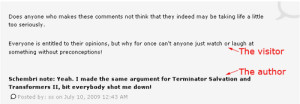Session 3, 'Next-generation approaches', of the UK Museums on the Web Conference 2008 was introduced by Jon Pratty.
Jon questioned, 'what is a virtual museum?. It can be pretty much anything. Lots of valuable historical documents aren't in 'online museum', they're just out there to be found by search. It raises the question – how much permanence should digital objects have?'.
George Oates, 'Sharing museum collections through Flickr'
Introducing the Flickr Commons project and talking about some early results. Some practical information on what it means to join the program, and things that have come out of it.
Flickr 'swerved in from left field' and bumped into museum people and librarians and archivists.
It started with Library of Congress thinking about how to engage with Web 2.0. They were looking for a Web 2.0 partner. They have 14 million images, about a million digitised.
Flickr is designed specifically to search and browse photos. It has a big infrastructure and supports interfaces in 8 languages. It has lots of eyeballs – "it's made of people".
From the Commons point of view, it's simply a service, organisations can publish content into it.
They hit a hurdle: can a collecting institution publish content onto a site like Flickr? As collecting institution, someone like the Library of Congress doesn't necessarily own the copyright or know who the copyright holder was. They devised a new statement – 'no known copyright restrictions' – this provided a way to use this content once institution had done as much work as they could to trace copyright so they could still publish if not able to trace copyright holders.
Might open up to other sorts of content.
What's it for? Increase access to public photography collections; gather context about them, [something else I missed].
Powerhouse – lots of the collection was geo-tagged. It means you can find photos from then and now, for example around the CBD of Sydney. [Cool! I love the way geo-tagging content lets you build up layers of history]
Brooklyn – it made sense to use their existing established Flickr account, so Flickr created functionality to support that. The Smithsonian joined on Monday.
Soon they'll have content from other partners including a charming collection from a tiny local museum.
Results:
Last 28 days Library of Congress – 15,000 [or 50,000?] views per day, 8 million views over last six months, 72,000 tags.
Powerhouse – 77,000 views (more views of that collection in one month than in the whole previous year), 3500 tags.
Brooklyn – figures affected by merged account issue.
Smithsonian – 10,000 views in first day, 100 new contacts
The numbers are probably affected by the ratio of photos e.g. smaller numbers when an institution has put fewer photos online.
"But, is it any good"?"
Suddenly there are conversations between Flickr users and institutions, and between Flickr users, contributing information and identifications.
They contribute the identification of places and people, with information about the history behind photos.
Now and then – people are adding their recent photos of a location via comments on Flickr.
Library of Congress have made a list of types of interactions [slides], they include the transcription of text on signs, posters, etc in background, geo-tags, non-English tags.
Institutional context and Flickr – bind them together with hyperlink, but being on Flickr frees a program from institutional constraints.
Flickr has been designed as a vessel or platform where interactions and conversations can happen.
The information that the community provides is proving useful. The Library of Congress has updated 176 records in catalogue, recording that it's based on 'information provided by Flickr Commons Project 2008'.
The Smithsonian found it was opportunity for collaboration between institutions/departments and staff.
How to join: the process is publish – interact – feedback.
What to think about: give a broad representation of what's in your collection. Think about placement of images in photostream and sets. Plan to attract special interest groups. Think about what is already digital, what is popular? It can direct your digitisation efforts with feedback from a live community. Or you could go into your stores or collections database and possibly digitised randomly.
How much metadata to include? How many fields from database into description of photo; more or less?
When: can be a challenge for institutions.
How? You could use the normal Flickr uploadr if you don't have too many images; or you could use API to write applications that will work with Collections Management Systems.
Who? Might be web technician and curator.
The catch? It costs $24.95 for a Pro account. But you get unlimited storage, and could conceivably put whole collection online.
The future:
It's a work in progress. Probably will end up developing tools like additional reporting
Grow gently (make sure institution can handle the changes and respond to interactions)
They will continue their focus on photographs, not photographs of objects "(sorry)". "Flickr is about … empathic photography"
"Go local" e.g. small archives in little towns – people can still participate even if they don't have a web team, or web site.
API methods, RSS
Searching, browsing, maps
Search across Commons coming soon. Maybe combine searches to see a map of photos taken in 1910.

